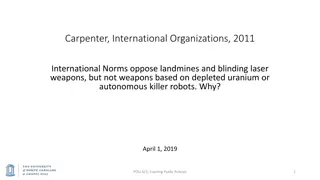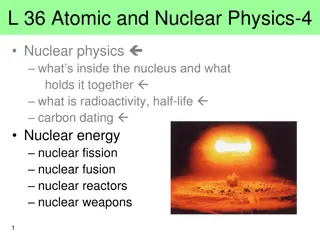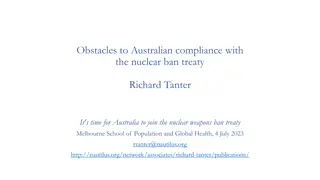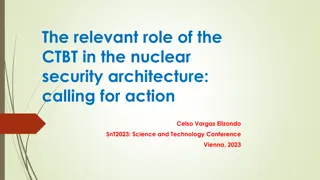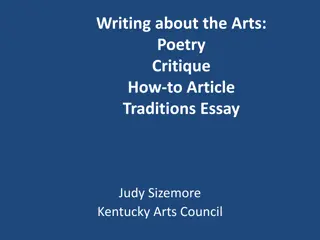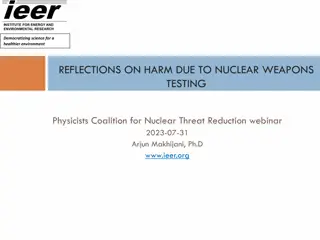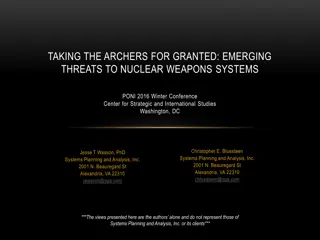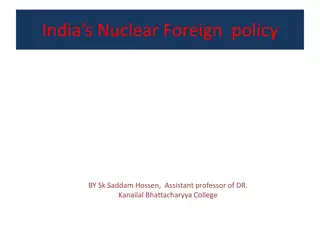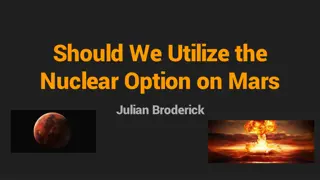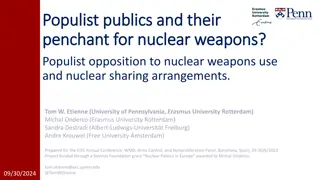History and Impact of Nuclear Weapons in Haiku and Senryu
Explore the use of nuclear weapons in history, particularly the events surrounding the atomic bombings in Japan in August 1945. Learn about Haiku and Senryu forms of poetry and create your own works reflecting on the impact of such weapons. Discover the current state of nuclear arsenals globally and contemplate the consequences of these powerful devices through poetic expression.
Download Presentation

Please find below an Image/Link to download the presentation.
The content on the website is provided AS IS for your information and personal use only. It may not be sold, licensed, or shared on other websites without obtaining consent from the author.If you encounter any issues during the download, it is possible that the publisher has removed the file from their server.
You are allowed to download the files provided on this website for personal or commercial use, subject to the condition that they are used lawfully. All files are the property of their respective owners.
The content on the website is provided AS IS for your information and personal use only. It may not be sold, licensed, or shared on other websites without obtaining consent from the author.
E N D
Presentation Transcript
Lesson 3: English: Haiku, Senryu, and nuclear weapons
What well do in this lesson: Explore at the USA s use of nuclear weapons against Japan in August 1945 Learn about Haiku and Senryu Try writing our own haiku and senryu about the bombings
Paul L. McCord Jr. ; https://creativecommons.org/licenses/by-nd/2.0/legalcode ; cropped Public domain ; National Museum of the US Navy
How many nuclear weapons are there in the world today? Nearly 14,500 in total, but not divided equally between the 9 countries Big decrease since the 1980s (70,000 warheads!), and 500 less than last year Almost 4000 of them could be used at short notice; 5500 are in storage; and 5000 are retired and will be dismantled in the coming years. But: several of the countries are increasing or upgrading theirs
Have nuclear weapons ever been used in a war?
trinityremembered.com 16th July 1945: The United States successfully tests the world s first ever atomic bomb (researchers 6 miles away are knocked over by the blast wave, and those 10 miles away felt heat on their face. Then, an unbelievably bright flash of light, described as ''beautiful'', then a defeaning roar, and a mushroom cloud 8 miles high in minutes)
Lord Mariser, https://creativecommons.org/licenses/by-sa/2.0/legalcode Harry Kidd ; https://creativecommons.org/licenses/by-nc-sa/2.0/legalcode 25th July 1945: President Truman gives the order to prepare to drop the atomic bomb on Japan (Britain gave its official consent on 4th July; Truman took over after Roosevelt died in April. The Manhattan Project was so secret that Truman hadn t been told about it as Vice-President!)
26th July 1945: Truman, Churchill and Chiang Kai-shek issue the Potsdam Declaration to Japan, which finished with the words: We call upon the government of Japan to proclaim now the unconditional surrender of all Japanese armed forces... The alternative for Japan is prompt and utter destruction. HarryKidd ; https://creativecommons.org/lice nses/by-nc-sa/2.0/legalcode
James Vaughan ; https://creativecommons.org/licen ses/by-sa/2.0/legalcode
Hiroshima video clip (reconstruction) You may find the clip disturbing. Feel free to close your eyes/look away.
Barefoot Gen Animated film made in 1983, based on the graphic novel by the famous Japanese manga artist Keiji Nakazawa, who survived the Hiroshima bomb (he was 6 at the time) You may find the clip disturbing! Feel free to close your eyes/look away.
Matthew Yglesias ; https://creativecommons.org/licenses/by-sa/2.0/legalcode 6th August 1945: President Truman gives a statement promising further bombs if Japan doesn t surrender
9th August 1945: The bomb is dropped on Nagasaki Wikimedia Commons
histclo.com 9th August 1945: At midnight, the USSR invades Manchuria, in Northern China, which since 1932 had been part of the Japanese Empire. They go on to capture Northern Korea and other Japanese-occupied territories.
Public domain 2nd September 1945: Japan formally surrenders. This is the end of the Second World War.
What are the arguments for the bombings? Saved lives: ended the war ASAP, saving lives overall by avoiding a land invasion (the Okinawa battle saw 1/3 of US landing force killed or wounded; Churchill said the USA and Britain would lose 1 million and 500,000 soldiers respectively) Revenge for Pearl Harbour Once the bomb was developed, it was always going to be used US National Archives
What are the arguments against the bombings? Immoral: Killed 185,000-600,000 - mostly civilians (Some of the leading Manhattan Projects scientists had asked decision-makers for the A-bomb to be used on ''uninhabited area'' of Japan instead, as a threat, but Truman had already decided on maximum impact, and couldn't risk failure of bomb demonstration. They only had two bombs, after all.) Surrender was possible: The US had intercepted telegrams showing that some of the Japanese government wanted Japan to surrender More about sending a message to the Soviet Union
WHAT DO YOU THINK? spectrum line
What is a Haiku? A haiku is a type of Japanese poem It s (usually) 3 lines and 17 syllables long: 5 syllables in the first line, 7 in the second, and 5 in the third Haikus say something epic in a few words. They were first written 100s of years ago, as the start of longer poems Usually about nature andhuman nature, with a season word, and a pause at end of the 1st or 2nd line Note: a haiku that is just about humans/human nature is called a Senryu
Toward those short trees We saw a hawk descending On a day in spring. by Masaoka Shiki (1867-1902) cerrodelaslombarda ; https://creativecommons.org/licenses/by-sa/2.0/legalcode To/ ward/ those/ short/ trees 5 syllables We/ saw/ a/ hawk/ de/ scend/ ing 7 On/ a/ day/ in/ spring 5 spring = season word
The day it ended Oh what else was there to do? Peace bought with the bomb by Anonymous The/ day/ it/ end/ed 5 syllables Oh/ what/ else/ was/ there/ to/ do? - 7 Peace/ bought/ with/ the/ bomb 5 = Haiku or senryu? Why?
Little boy humming Dragonfly strumming, gamma numbing, black rain coming. by Anthony Owen Lit/ tle/ boy/ humm/ ing 5 syllables Dra/ gon/ fly/ strumm/ ing/ gam/ ma 7 numb/ ing,/ black/ rain/ com/ ing 6 ( This shows that there can be exceptions!) rain = season word
YOUR TASK: YOUR TASK: Write your own haiku/senryu about Hiroshima and Nagasaki 1. Write a haiku or senryu about the bombings from the point of view of someone alive at the time (you ll be given a Witness Statement ) 2. Think about how that person felt about the bombings. 3. If you have time, write a haiku/senryu from your own point of view, too
You will write your haiku/senryu from the point of view of one of these people (you may remember them as witnesses in the trial!): Nagasaki survivor Bomber pilot Truman s advisor Japanese Army General American civilian Nuclear Scientist
Share your haiku/senryu with the rest of the class !




